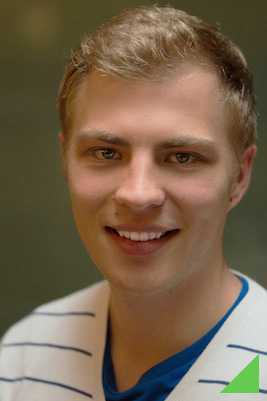Team:Oxford/team
From 2014.igem.org
(Difference between revisions)
| Line 216: | Line 216: | ||
<img src="https://static.igem.org/mediawiki/2014/3/34/George.jpg" style="z-index:6;position:absolute;margin-top:105%;width:15%;border-right: 510px solid #f9f9f9; border-top-right-radius:15px;border-bottom-left-radius:15px;" /> | <img src="https://static.igem.org/mediawiki/2014/3/34/George.jpg" style="z-index:6;position:absolute;margin-top:105%;width:15%;border-right: 510px solid #f9f9f9; border-top-right-radius:15px;border-bottom-left-radius:15px;" /> | ||
<div style="z-index:6;position:absolute;margin-top:106%;width:500px;color:black;margin-left:16%;"><font style="font-size:large;">Dr. George Wadhams</font><br><br> | <div style="z-index:6;position:absolute;margin-top:106%;width:500px;color:black;margin-left:16%;"><font style="font-size:large;">Dr. George Wadhams</font><br><br> | ||
| - | + | George Wadhams’ research interest lie in understanding how bacteria sense and integrate environmental information. In particular, his group is trying to understand in a quantitative manner how multiple, homologous pathways operate in individual cells and how the components of these pathways can be used to create synthetic pathways to achieve engineering solutions. </div> | |
<img src="https://static.igem.org/mediawiki/2014/2/2f/OxigemCiaran.jpg" style="z-index:6;position:absolute;margin-top:127.5%;width:15%;right:0%;border-left: 510px solid #f9f9f9; border-top-right-radius:15px;border-bottom-left-radius:15px;" /> | <img src="https://static.igem.org/mediawiki/2014/2/2f/OxigemCiaran.jpg" style="z-index:6;position:absolute;margin-top:127.5%;width:15%;right:0%;border-left: 510px solid #f9f9f9; border-top-right-radius:15px;border-bottom-left-radius:15px;" /> | ||
<div style="z-index:6;position:absolute;margin-top:128.5%;width:500px;color:black;right:15%;"><font style="font-size:large;">Dr. Ciarán Kelly</font><br><br> | <div style="z-index:6;position:absolute;margin-top:128.5%;width:500px;color:black;right:15%;"><font style="font-size:large;">Dr. Ciarán Kelly</font><br><br> | ||
| - | + | Ciarán Kelly obtained a PhD for his work in Frank Sargant’s group, constructing and characterising synthetic biohydrogen production pathways in E. coli. He is interested in the construction, characterisation, and re-engineering synthetic enzymes and pathways for the production of high-value chemicals. </div> | |
<img src="https://static.igem.org/mediawiki/2014/0/08/Oxigemradcamcrop.jpg" style="position:absolute; z-index:5; width:100%;margin-top:150%;min-width:320px; border-radius:15px;border-bottom-left-radius:15px;"/> | <img src="https://static.igem.org/mediawiki/2014/0/08/Oxigemradcamcrop.jpg" style="position:absolute; z-index:5; width:100%;margin-top:150%;min-width:320px; border-radius:15px;border-bottom-left-radius:15px;"/> | ||
| Line 231: | Line 231: | ||
<img src="https://static.igem.org/mediawiki/2014/d/da/Judy.jpg" style="z-index:6;position:absolute;margin-top:163%;width:15%;border-right: 510px solid #f9f9f9; border-top-right-radius:15px;border-bottom-left-radius:15px; " /> | <img src="https://static.igem.org/mediawiki/2014/d/da/Judy.jpg" style="z-index:6;position:absolute;margin-top:163%;width:15%;border-right: 510px solid #f9f9f9; border-top-right-radius:15px;border-bottom-left-radius:15px; " /> | ||
<div style="z-index:6;position:absolute;margin-top:164%;width:500px;color:black;margin-left:16%;"><font style="font-size:large;">Professor Judy Armitage</font><br><br> | <div style="z-index:6;position:absolute;margin-top:164%;width:500px;color:black;margin-left:16%;"><font style="font-size:large;">Professor Judy Armitage</font><br><br> | ||
| - | + | Judy Armitage is interested in the dynamics of bacterial sensory transduction and the control of bacterial motility. In particular, her research group focuses on the communication between the sensory and adaption mechanisms of the two pathways as a model for sensory network integration in general..</div> | |
<img src="https://static.igem.org/mediawiki/2014/0/05/OxigemAnthony.jpg" style="z-index:6;position:absolute;margin-top:185.5%;width:15%;right:0%;border-left: 510px solid #f9f9f9; border-top-right-radius:15px;border-bottom-left-radius:15px;" /> | <img src="https://static.igem.org/mediawiki/2014/0/05/OxigemAnthony.jpg" style="z-index:6;position:absolute;margin-top:185.5%;width:15%;right:0%;border-left: 510px solid #f9f9f9; border-top-right-radius:15px;border-bottom-left-radius:15px;" /> | ||
<div style="z-index:6;position:absolute;margin-top:186.5%;width:500px;color:black;right:15%;"><font style="font-size:large;">Professor Anthony Watts</font><br><br> | <div style="z-index:6;position:absolute;margin-top:186.5%;width:500px;color:black;right:15%;"><font style="font-size:large;">Professor Anthony Watts</font><br><br> | ||
| - | + | Anthony Watts’ group is devising solid state NMR methods for determining high-resolution details of information-rich sites within membrane receptors. Recent focus has been on the neurotensin receptor (NTS1), which is now available highly purified and monodispersed in detergent as well as in a ligand-binding form. </div> | |
<img src="https://static.igem.org/mediawiki/2014/4/4f/OxigemAntonis.jpg" style="z-index:6;position:absolute;margin-top:209%;width:15%;border-right: 510px solid #f9f9f9; border-top-right-radius:15px;border-bottom-left-radius:15px;" /> | <img src="https://static.igem.org/mediawiki/2014/4/4f/OxigemAntonis.jpg" style="z-index:6;position:absolute;margin-top:209%;width:15%;border-right: 510px solid #f9f9f9; border-top-right-radius:15px;border-bottom-left-radius:15px;" /> | ||
<div style="z-index:6;position:absolute;margin-top:210%;width:500px;color:black;margin-left:16%;"><font style="font-size:large;">Professor Antonis Papachristodolou</font><br><br> | <div style="z-index:6;position:absolute;margin-top:210%;width:500px;color:black;margin-left:16%;"><font style="font-size:large;">Professor Antonis Papachristodolou</font><br><br> | ||
| - | + | Antonis Papachristodoulou’s research interests include systems and synthetic biology, network systems, aerospace systems and flow control, and convex optimisation. Furthermore, he works on modern control theory, robust stability analysis and design, as well as nonlinear dynamical systems and Lyapunov stability. </div> | |
</div> | </div> | ||
Revision as of 19:34, 16 September 2014
 "
"





























